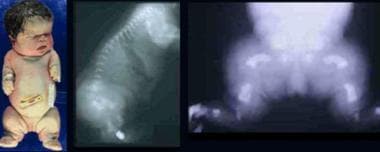Background
Thanatophoric dysplasia (TD) is the most common form of skeletal dysplasia known to be lethal in the neonatal period. The term thanatophoric derives from the Greek word thanatophorus, which means “death bringing” or “death bearing.” Salient phenotypic features of TD include macrocephaly, narrow bell-shaped thorax with shortened ribs, normal trunk length, and severe shortening of the limbs. See the image below.
Infant with thanatophoric dysplasia. Note short-limbed dysplasia, large head, short neck, narrow thorax, short and small fingers, and bowed extremities. Radiographs demonstrate thin flattened vertebrae, short ribs, small sacrosciatic notch, extremely short long tubular bones, and markedly short and curved femora (telephone receiver–like appearance).
TD is divided into 2 clinically defined subtypes: TD type I (TD-I or TD-1) and TD type II (TD-II or TD-2). The clinical subtypes of TD are defined by either a curved or straight appearance of the long bones. TD-I, the more common subtype, is characterized by a normal-shaped skull and curved long bones (shaped like old-fashioned telephone receivers); the femurs are most affected in TD-I. TD-II is associated with a cloverleaf-shaped skull and straight femurs. However, reported cases have cited clinical overlap between these subtypes.
Both TD-I and TD-II are part of a group of skeletal disorders associated with mutations within the Fibroblast Growth Factor Receptor 3 gene (FGFR3). TD-I and TD-II are due to an autosomal dominant point mutation, with the gene responsible, FGFR3, being mapped to the short arm of chromosome 4 (4p16.3). Penetrance of this mutation is 100%. Currently, all cases of TD are due to de novo mutations in FGFR3. Germline mosaicism has not been clearly documented but remains a theoretical possibility.

